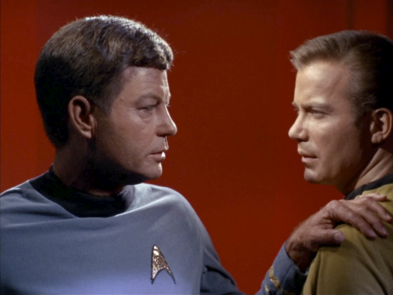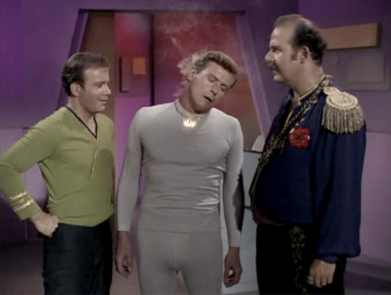This is the third in a series of posts about the maths of Star Trek. Part I covered the probability of survival while wearing a red shirt, and Part II discussed the mathematics of alien biology.
Are we alone in the galaxy? Drake’s Equation
In the episode ‘Balance of Terror’, Captain Kirk and Doctor McCoy find themselves in reflective mood and the question of our uniqueness in the galaxy is discussed:
KIRK: I wish I were on a long sea voyage somewhere. Not too much deck tennis, no frantic dancing, and no responsibility. Why me? I look around that Bridge, and I see the men waiting for me to make the next move. And Bones, what if I’m wrong?
MCCOY: Captain, I…
KIRK: No, I don’t really expect an answer.
MCCOY: But I’ve got one. Something I seldom say to a customer, Jim. In this galaxy, there’s a mathematical probability of three million Earth-type planets. And in all of the universe, three million million galaxies like this. And in all of that, and perhaps more, only one of each of us. Don’t destroy the one named Kirk.
Here, McCoy is applying an idea similar to one used by astronomers today to estimate the number of active alien civilisations in our galaxy that might have radio technology, which we can then detect with our large radio receivers.
To estimate this number, in 1961 astrophysicist Frank Drake came up with the following formula:
\[N= R_* \times f_p \times n_e \times f_\ell \times f_i \times f_c \times L\]
with parameters;
- $R_*$, the average rate of star formation per year in our galaxy. Drake and his colleagues originally gave this a conservative estimate of 1 star per year. Current estimates from NASA would now put this at around 7 per year.
- $f_p$, the fraction of those stars that have planets. Drake originally estimated this fraction to be around 20%-50%. Current estimates are closer to 100%, in that stars without planets appear to be the exception rather than the rule.
- $n_e$, the average number of planets that can potentially support life per star that has planets. Drake estimated this to be around 1-5 planets per star. NASA have said 5.4% of stars may host a terrestrial planet, making 0.054 planets per star.
- $f_\ell$, the fraction of the above that actually go on to develop planetary life at some point. Drake put this value at 100%, and it is still thought to be very high.
- $f_i$, the fraction of the above that actually go on to develop intelligent life. Again, Drake estimated this to be 100%, but the true value for this parameter is unknown.
- $f_c$, the fraction of civilizations that develop a technology that releases detectable signs of their existence into space. Drake’s estimate was 10%-20%, although any sufficiently advanced civilisation may be thought of as ‘broadcasting’ even if not intentionally.
- $L$, the length of time for which such civilizations release detectable signals into space. Drake and his colleagues estimated this to be between 1000 and 1,000,000,000 years. The average human civilisation has only lasted 420 years, but an advanced society might be able survive perpetually.
Drake and his colleagues concluded that, given the uncertainties, $N \approx L$, meaning there were probably between 1000 and 100,000,000 civilizations in the galaxy which we could detect.
Our current estimates put $N \approx \frac{L}{5}$, which means the determining factor for communication is still $L$, the length of time we can expect an advanced civilisation with broadcasting technology to last.
The original intention of the formula was to promote discussion between Drake and his colleagues, and many of the variables of Drake’s equation are open to conjecture. Estimates for the number of active civilisations with radio communication in our galaxy has ranged from the tens of millions to Earth being alone in the galaxy. One thing that can be agreed on is that the existence of human civilisation proves it’s not zero.
Drake’s equation was used by Gene Roddenberry in 1964 in his pitch for Star Trek to justify the large number of inhabited planets in the show. He did not have a copy of the equation so he made up his own. Roddenberry’s formula was as follows:
$$F f^2 (MgE) – C^1 Ri^1 \times M = L / So$$
No explanation of the parameters of Roddenberry’s equation were given, however both forms of the formula may be seen on a poster as a background detail in a later episode of Star Trek: Voyager.
It is said that Drake himself visited the set one day, and even viewed Roddenberry’s “second variation”, before gently pointing out that a value raised to the first power is merely the value itself.
A similar mistake later made it to the screen in one of Star Trek’s most notorious mathematical gaffs. In ‘Court Martial’ Kirk searches for a missing crewmember by removing the remainder of the crew and using the ship’s sensors to pick up a heartbeat:
KIRK: Ready, Mister Spock?
SPOCK: Affirmative, Captain.
KIRK: Gentlemen, this computer has an auditory sensor. It can, in effect, hear sounds. By installing a booster, we can increase that capability on the order of one to the fourth power. The computer should bring us every sound occurring on the ship.
Unfortunately, no one points out to Kirk that 1 to the fourth power is still 1.
In recent years, some wags have repurposed Drake’s equation, not to work out the probability of finding intelligent life, but to work out the probability they will find a girlfriend. Parameters include rate of people formation (birth rate), fraction of people who are women (51%), and fraction of age-appropriate women the author finds attractive (various estimates). When applied, the author invariably discovers that the probability is very low.
Next we will consider a different type of intelligent civilisation – android civilisation. It’s life Jim, but not as we know it.
20th century mathematicians and 23rd century androids – The Liar’s Paradox
Throughout the original series, Captain Kirk talked a computer to death on no less than four different occasions, through the use of paradoxes or other dilemmas.
For example, in ‘I Mudd’ Kirk and co are kidnapped and held by a planet of androids. Here, after seeding confusion by miming an explosion, Kirk and the rogue Harry Mudd introduce a paradox to Norman, the android leader:
NORMAN: But there was no explosion.
MUDD: I lied.
NORMAN: What?
KIRK: He lied. Everything Harry tells you is a lie. Remember that. Everything Harry tells you is a lie.
MUDD: Listen to this carefully, Norman. I am lying.
NORMAN: You say you are lying, but if everything you say is a lie then you are telling the truth, but you cannot tell the truth because everything you say is a lie. You lie. You tell the truth. But you cannot for. Illogical! Illogical! Please explain.
(Smoke comes out of Norman’s head.)
Unable to resolve the paradox, Norman goes blank, leaving the crew of the Enterprise to escape. This is known as the Liar’s Paradox and may be more simply stated as: “This sentence is false”.
It turns out that the Liar’s Paradox is central to one of the greatest results in 20th century mathematics – but a result that led to many mathematicians with smoke coming out of their head.
Mathematics is built from a number of basic truths called ‘axioms’, from which we prove other results. For example, some axioms of arithmetic might be that $0$ is a natural number, and all natural numbers have a successor. From these basic truths we can prove such results as $1 + 1 = 2$. In fact, this result was proved in 1910 by Alfred North Whitehead and Bertrand Russell and appears on page 86, Volume II of their book Principia Mathematica.
At the beginning of the 20th century, logicians such as Whitehead, Russell, and David Hilbert wanted to worked out these basic truths of mathematics, from which all other mathematical results can be proven. Importantly, the system of axioms would need to be ‘complete’, so they could be used to prove all true results, and ‘consistent’, so we always get the same result no matter how we choose to prove it. In other words, we don’t find anything contradictory like $1 = 2$.
In 1931, the Austrian American mathematician, Kurt Gödel rocked the mathematical community with the proof of what is now known as Gödel’s Incompleteness Theorems. In his proof, Gödel could represent statements with numbers, so any system that can be used to prove facts of arithmetic, may also be used to prove facts about its own statements.
Now replace the sentence “This sentence is false” in the Liar’s Paradox, with the sentence “This sentence is not provable”. Gödel showed that a number representing such a statement can always be constructed, meaning the system could not be both complete and consistent. In other words, some results will be true but not provable within that framework.
The use of paradoxes against artificial life must have become required reading at Starfleet academy. Later, Captain Picard and the crew of the Enterprise D come up with a similar tactic of using an Escher-style picture to destroy the Borg… but that’s an essay for another time.







Order of one doesn’t mean 1. It usually (at least in physics) means the most significant digit. So, Spock could have very well meant that the capability was 2, 3 or even 4.9 (5 might be considered an order of ten though).
But it’s not necessarily “on the order of 1” “to the power of 4”. I would say it’s more intuitive to be read as “on the order of” “one to the power of 4”. If it was correctly written as “on the order of ten to the power of 4” you would consider that “on the order of ten thousand” not “somewhere between 5^4=625 and 15^4=50625”.
That’s generally referred to as an order of magnitude (powers of ten to non-physicists), however, but yes, agree “of the same order of magnitude” in a physics context can mean up to 9x bigger. Don’t think that was the scriptwriters intention though.
In that case he could still have just said “on the order of one” rather than “on the order of one to the fourth power”.
Guys, guys. I’ve discovered the solution to the 1x1x1x1 problem.
What Kirk meant to say was:
“By installing a booster we can increase that capability on the order of one, to the fourth power.”
(I’ve moved the comma, Kirk had the comma in his script in the wrong place.) Now it reads as meaning “after we’ve ordered [purchased] a booster, the
capability is increased to the fourth power.”
;-)
So you reckon the “on the order of one” bit was just redundant verbiage? I’m not convinced.
What application does Godel’s liars paradox proof have–beyond destroying optimistic dreams of prooving all maths as complete and consistent? Like is this the reason that 9.999repeating is actually 10?
I Love Star Trek.